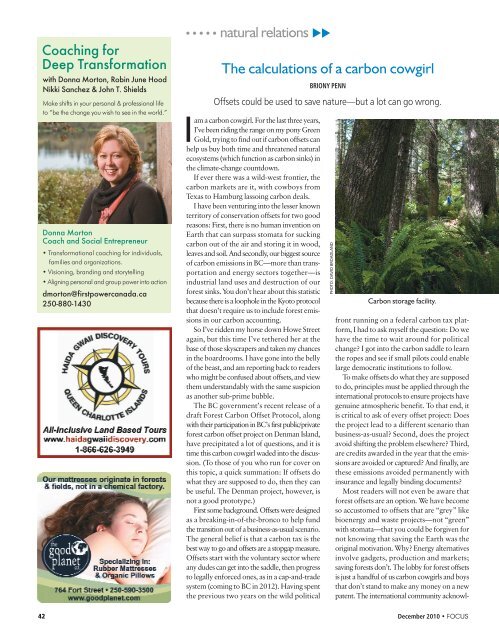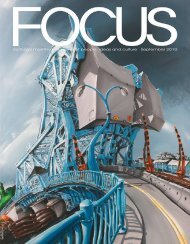****December 2010 Focus - Focus Magazine
****December 2010 Focus - Focus Magazine
****December 2010 Focus - Focus Magazine
You also want an ePaper? Increase the reach of your titles
YUMPU automatically turns print PDFs into web optimized ePapers that Google loves.
Coaching for<br />
Deep Transformation<br />
with Donna Morton, Robin June Hood<br />
Nikki Sanchez & John T. Shields<br />
Make shifts in your personal & professional life<br />
to “be the change you wish to see in the world.”<br />
Donna Morton<br />
Coach and Social Entrepreneur<br />
• Transformational coaching for individuals,<br />
families and organizations.<br />
• Visioning, branding and storytelling<br />
• Aligning personal and group power into action<br />
dmorton@firstpowercanada.ca<br />
250-880-1430<br />
..... natural relations<br />
Iam a carbon cowgirl. For the last three years,<br />
I’ve been riding the range on my pony Green<br />
Gold, trying to find out if carbon offsets can<br />
help us buy both time and threatened natural<br />
ecosystems (which function as carbon sinks) in<br />
the climate-change countdown.<br />
If ever there was a wild-west frontier, the<br />
carbon markets are it, with cowboys from<br />
Texas to Hamburg lassoing carbon deals.<br />
I have been venturing into the lesser known<br />
territory of conservation offsets for two good<br />
reasons: First, there is no human invention on<br />
Earth that can surpass stomata for sucking<br />
carbon out of the air and storing it in wood,<br />
leaves and soil. And secondly, our biggest source<br />
of carbon emissions in BC—more than transportation<br />
and energy sectors together—is<br />
industrial land uses and destruction of our<br />
forest sinks. You don’t hear about this statistic<br />
because there is a loophole in the Kyoto protocol<br />
that doesn’t require us to include forest emissions<br />
in our carbon accounting.<br />
So I’ve ridden my horse down Howe Street<br />
again, but this time I’ve tethered her at the<br />
base of those skyscrapers and taken my chances<br />
in the boardrooms. I have gone into the belly<br />
of the beast, and am reporting back to readers<br />
who might be confused about offsets, and view<br />
them understandably with the same suspicion<br />
as another sub-prime bubble.<br />
The BC government’s recent release of a<br />
draft Forest Carbon Offset Protocol, along<br />
with their participation in BC’s first public/private<br />
forest carbon offset project on Denman Island,<br />
have precipitated a lot of questions, and it is<br />
time this carbon cowgirl waded into the discussion.<br />
(To those of you who run for cover on<br />
this topic, a quick summation: If offsets do<br />
what they are supposed to do, then they can<br />
be useful. The Denman project, however, is<br />
not a good prototype.)<br />
First some background. Offsets were designed<br />
as a breaking-in-of-the-bronco to help fund<br />
the transition out of a business-as-usual scenario.<br />
The general belief is that a carbon tax is the<br />
best way to go and offsets are a stopgap measure.<br />
Offsets start with the voluntary sector where<br />
any dudes can get into the saddle, then progress<br />
to legally enforced ones, as in a cap-and-trade<br />
system (coming to BC in 2012). Having spent<br />
the previous two years on the wild political<br />
▲ ▲<br />
The calculations of a carbon cowgirl<br />
BRIONY PENN<br />
Offsets could be used to save nature—but a lot can go wrong.<br />
PHOTO: DAVID BROADLAND<br />
Carbon storage facility.<br />
front running on a federal carbon tax platform,<br />
I had to ask myself the question: Do we<br />
have the time to wait around for political<br />
change I got into the carbon saddle to learn<br />
the ropes and see if small pilots could enable<br />
large democratic institutions to follow.<br />
To make offsets do what they are supposed<br />
to do, principles must be applied through the<br />
international protocols to ensure projects have<br />
genuine atmospheric benefit. To that end, it<br />
is critical to ask of every offset project: Does<br />
the project lead to a different scenario than<br />
business-as-usual Second, does the project<br />
avoid shifting the problem elsewhere Third,<br />
are credits awarded in the year that the emissions<br />
are avoided or captured And finally, are<br />
these emissions avoided permanently with<br />
insurance and legally binding documents<br />
Most readers will not even be aware that<br />
forest offsets are an option. We have become<br />
so accustomed to offsets that are “grey” like<br />
bioenergy and waste projects—not “green”<br />
with stomata—that you could be forgiven for<br />
not knowing that saving the Earth was the<br />
original motivation. Why Energy alternatives<br />
involve gadgets, production and markets;<br />
saving forests don’t. The lobby for forest offsets<br />
is just a handful of us carbon cowgirls and boys<br />
that don’t stand to make any money on a new<br />
patent. The international community acknowl-<br />
42 December <strong>2010</strong> • FOCUS
















